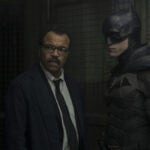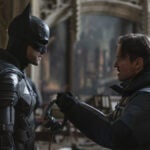
“The Batman” is one of the most gorgeous movies of the year, full of richly imagined environments and beautiful sets, which makes the home video release of the movie (it’s now on digital HD, Blu-ray, and, crucially 4K HD Blu-ray) even more essential. Now you can properly luxuriate in filmmaker Matt Reeves’ unique, perpetually rain-soaked vision of Gotham City and search for all the hidden clues and details.
If for some reason you haven’t seen “The Batman,” it follows a new Dark Knight in his second year of operation (played, with brooding intensity, by Robert Pattinson) as he goes up against the Riddler (Paul Dano), as he cuts a bloody swath through Gotham City’s underworld, targeting politicians and criminals alike (although the line is a bit blurry, especially in Gotham). Bruce Wayne/Batman also teams up with Selina Kyle (Zoë Kravitz) to help solve this maddening and murderous mystery. The Gotham City that this Batman inhabits is both eerie and familiar; an identifiable American metropolis adorned and embellished by fantastical elements. It’s a stunner.
TheWrap spoke to “The Batman” production designer James Chinlund about putting his own stamp on Gotham, what he wanted to use from earlier iterations of the city, and how their new version of the Batmobile was meant to evoke Stephen King’s “Christine.”
What were those initial conversations like with Matt? How did he present it to you?
I think both of us were freaking out, where we’re basically trying to figure out where was the new space, because there have been so many iterations of Batman that came before, and we love them all in different ways. I think it’s an intimidating wall of history and art that you’re walking into. And we knew we wanted to deliver something familiar for the fans, and at the same time, something new. And I think that’s where Matt’s genius and leadership came in – he zeroed in on this idea about Bruce, and who he could be, and where he could be in his development as a superhero. That was the key for me as a designer to start opening up the world and following that path as we went forward. I think the idea that Bruce is early in his in his career and has turned his back on Wayne Industries and is doing it himself, in and of itself created new space that we hadn’t seen. We followed that line through the film.
What about specifically Gotham City –we’ve seen so many different versions and Tim Burton’s is the most iconic version. But what was your approach?
Well, I mean, as I said, there have been so many that were that were so inspiring to us. And like you said, Tim Burton holds one pole, I think, you know, Chris Nolan and his team did an amazing job on their side of things. I think Chris and his team were really delivering a super-grounded take that, sort of James Bond in a way. And then obviously, Tim, you know, it was a fully fleshed-out cartoon world, like a fully realized fantasy space. And for us, I think what we were hopeful that we could create a Gotham that felt simultaneously real and grounded, and like a place you could go, but also fulfilled all the feelings and emotions that you got off the Burton world, this murky spooky world. It was a real challenge, trying to figure out how to balance those two desires. And hopefully, we did.
What about the exploratory phase – do you remember some crazy designs for things that just were so different than what ended up in the final movie?
I think the Iceberg Lounge, in and of itself, is just the collision of so many narrative threads, and the geography that was responsible for so much, that we went through a ton of iterations on, whether we were going to build the club or use the location. I mean, I think there are a lot of ideas that hit the floor that didn’t make it into the film that were really cool. But at the end of the day, I’m proud of what we delivered there.
There was a pre-Burton version where the Iceberg Lounge was an actual cold, frigid club. Did you ever explore ideas like that?
We certainly did. There was a lot. There was big water sets and all sorts of ideas. But I think at the end, the 44 Below club contains some of that. It’s shot all in thermal cam. The details are hidden in the shadows. But you can feel some of that down there. That’s just part of the process. You know, as a designer, I think you’re cutting away the extra fat and getting down to the core of the idea and what’s going to stick and so it’s a pleasure, toying with things and seeing them fall away, because I think at the end, you get the essence of what it needed to be.
Your designs also have to serve the theme and also the characters, a great example being the new Batcave. What was the thinking behind that it being a disused subway station?
That was early in the development. And I think Matt and I were both excited about the idea of Bruce as an urban Batman that he was going to be anchored in the center of the city and Wayne Tower. And so following that line, trying to figure out what would it be on, as a New Yorker, I understand the underground of the city and how tight that space is, full of sewer lines and power lines.
I had heard this story about the Waldorf Astoria, there’s a train that they keep under the Waldorf Astoria for the President so that in the event of an emergency, he may be whisked out of the city. I always thought that was such a romantic idea. I just followed that line for the Waynes’ thinking that they might have their own private train station, that they could come and go from Wayne Tower without bumping into the hoi polloi on the street. It was just a nice kernel of an idea that led us also follow the line to the elevator and the Shakespeare bust and all those sorts of things.
Was it disappointing that you couldn’t put the dinosaur or the giant coin back there?
I think there’s always an opportunity to see into the shadows there. But I do also think that those sorts of ideas, like live firmly in the comic book world in a way that like we haven’t touched on, also, those are supposed to be souvenirs from amazing adventures of the world’s greatest detective. And here’s Bruce just starting out.
People are obsessed with your Batmobile for obvious reasons. There’s a weird debate on Twitter about whether the car floods or if he means to turn it off.
I mean, for us, there’s what we were calling the furnace in the front of the car. Matt was excited about having this kind of “Christine”-like energy to the car that it had its own life. And we created this jet engine intake idea at the front that was like as if it was breathing. I think you may see the vents open and close. And our hope was that we were creating lungs, essentially, they were sort of seeing it start to come to life.
Well, we’ve got the announcement that there’s another one coming. Have you started designing yet?
I’m always dreaming, always dreaming. I’m really excited. I hope it happens.
“The Batman” is on DVD, Blu-ray and 4K HD Blu-ray right now.
















